Antanas Smetona
Antanas Smetona (Lithuanian: [ɐnˈtaːnɐs sʲmʲɛtoːˈnɐ] (![]()
Antanas Smetona | |
|---|---|
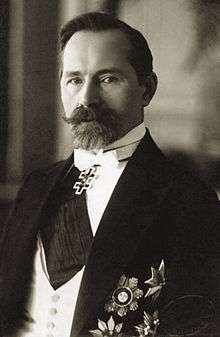 | |
| President of Lithuania | |
| In office 19 December 1926 – 15 June 1940 | |
| Prime Minister | Augustinas Voldemaras Juozas Tūbelis Vladas Mironas Jonas Černius Antanas Merkys |
| Preceded by | Aleksandras Stulginskis (Acting) |
| Succeeded by | Antanas Merkys (Acting) |
| In office 4 April 1919 – 19 June 1920 | |
| Prime Minister | Pranas Dovydaitis Mykolas Sleževičius Ernestas Galvanauskas |
| Succeeded by | Aleksandras Stulginskis |
| Personal details | |
| Born | 10 August 1874 Užulėnis, Kovno Governorate, Russian Empire |
| Died | 9 January 1944 (aged 69) Cleveland, Ohio, U.S. |
| Resting place | All Souls Cemetery, Chardon, Ohio |
| Political party | Lithuanian Democratic Party (1902–1907) Party of National Progress (before 1924) Lithuanian Nationalist Union (1924–1940) |
| Spouse(s) | Sofija Chodakauskaitė-Smetonienė (1885–1968) |
| Children | Marija Danutė (1905–1992) Birutė (1906–1909) Julius Rimgaudas (1913–1974) |
| Alma mater | University of Saint Petersburg |
| Signature | |
Early life and education
Smetona was born on 10 August [O.S. 28 July] 1874 in the village of Užulėnis, Kovno Governorate, Russian Empire, to a family of farmers – former serfs of the Taujėnai Manor, which belonged to the Radziwiłł family.[1] Researcher Kazimieras Gasparavičius has traced Smetona's patrilineal ancestry to Laurentijus who was born around 1695 and lived near Raguva.[2] Smetona was the eighth of nine children.[3] His parents were hardworking people who managed to double their inherited 5 hectares (12 acres).[4] His father was literate and Smetona learned to read at home.[5]
.jpg)
His father died in 1885 when Smetona was only 11 years old and, despite financial difficulties, a year later Smetona – the only of his siblings – was sent to the primary school in Taujėnai where instruction was in Russian due to the Lithuanian press ban.[6] This was his dying father's request.[7] His mother hoped that Smetona would become a priest.[8] After graduation in 1889, Smetona wanted to continue his education, but gymnasiums admitted pupils only up to the age of 12 and he was already 15 years old. Therefore, he was forced to study privately in Ukmergė in order to catch up and be able to pass examinations to enter the fourth class of gymnasium.[9] In summer 1891, he attempted to gain admission to the Liepāja Gymnasium as his brother Motiejus worked in a factory in Liepāja.[10] He was refused and instead applied to the Palanga Pre-Gymnasium, which had no age restrictions.[11] Smetona was an exemplary student (one of the top two students) and received a tuition waiver. As a superintendent of a student dormitory, he also received free housing and was able to support himself by providing private lessons.[12] Three other future signatories of the Act of Independence of Lithuania attended the Pro-Gymnasium at the same time: Steponas Kairys, Jurgis Šaulys, and Kazimieras Steponas Šaulys.[13] As Palanga was close to East Prussia, it was easier to obtain Lithuanian literature, which was banned by the Tsarist authorities. Smetona began reading Lithuanian periodicals and books, including a history of Lithuania by Maironis.[14]
After graduation in 1893, according to his family's wishes, he passed his entrance examinations for the Samogitian Diocesan Seminary in Kaunas.[15] However, he felt no great calling for priesthood and enrolled at the Jelgava Gymnasium in Latvia. This was a cultural hub of the Lithuanian National Revival and attracted many future leaders in Lithuanian culture and politics, including Juozas Tūbelis and Vladas Mironas who later became Smetona's political companions.[15] In particular, Lithuanian language and culture was openly promoted by the linguist, Jonas Jablonskis, teacher of Greek, with whom Smetona developed a close professional relationship.[16] Jablonskis visited Smetona's native village collecting data on Lithuanian dialects.[17] Smetona met his future wife, Sofija Chodakauskaitė, through Jablonskis who recommended him as tutor for her brother.[18]
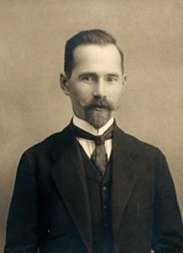
In fall 1896, the administration of the Jelgava Gymnasium forced the Lithuanian students to recite their prayers in Russian while Latvian and German students were allowed to use their native languages.[19] Smetona and other students refused and were expelled. Most later agreed to pray in Russian and were re-admitted, but a handful who refused were prohibited from attending any other school.[20] The students sent petitions to Pope Leo XIII and Ivan Delyanov, Minister of National Education.[21] Smetona and two others, Jurgis Šlapelis and Petras Vaiciuška, managed to secure an audience with Delyanov who allowed the Lithuanians to pray in Latin and the expelled students to continue their education.[22] Smetona did not return to Jelgava and finished up at Gymnasium No. 9 in Saint Petersburg.[23]
Upon graduation in 1897, Smetona entered the Faculty of Law of the University of Saint Petersburg. He was more interested in history and languages, but knew that as a Catholic his choices were limited to priest, lawyer, or doctor if he wanted to work in Lithuania.[23] Saint Petersburg, with a direct railway connection to Lithuania, was becoming a Lithuanian cultural center. Smetona joined and chaired a secret Lithuanian student organization; he was later succeeded by Steponas Kairys.[24] He also joined a Lithuanian choir led by Česlovas Sasnauskas, organist at the Church of St. Catherine.[25] Smetona was exposed to socialist ideas and even read Marx's Capital, but resolutely rejected them.[24] He was expelled from the university, imprisoned for two weeks, and deported to Vilnius for participating in the February 1899 student protests.[23] It was the first time Smetona visited the city, the historical capital of the Grand Duchy of Lithuania, and it left a deep impression on him.[23] A month later, he was allowed to return to the university.[26]
In 1898, Smetona and his roommate, Vladas Sirutavičius, using a mimeograph printed about 100 copies of a brief Lithuanian grammar written by Petras Avižonis based on the German-language writings of Frydrichas Kuršaitis.[26] This grammar was insufficient for Lithuanian needs and in summer 1900 Jonas Jablonskis set out to work on his Lithuanian grammar. He was assisted by Avižonis, Žemaitė, and Smetona, though Smetona mostly edited works of Bishop Motiejus Valančius.[18] The grammar was published in 1901 and became a fundamental work in establishing the standard Lithuanian language.[18] In early 1902, the police began investigating a network of Lithuanian book smugglers and raided Smetona's room where they found several prohibited Lithuanian publications. He was imprisoned in the Vyborg Castle, but managed to secure acquittal and graduate that spring.[27]
Early activities
After his graduation from the University in 1902, he moved to Vilnius and worked at the Vilnius Land Bank until 1915. He became an active participant in Lithuanian cultural life and, up until becoming President in December 1926, devoted substantial amounts of time and effort to the Lithuanian press.[28] Two years later, he married Sofija Chodakauskaitė in the Church of St. Raphael the Archangel in Vilnius.[29]
From his very first days in Vilnius, Smetona became involved in the activities of various Lithuanian nationalist groups, and joined the Lithuanian Democratic Party, which he represented in the Great Seimas of Vilnius. He was later elected to its Presidium. In 1904 and 1907, he was on the staff of the Lithuanian newspaper, Vilniaus žinios (The Vilnius News). In 1905–1906, he edited the weekly Lietuvos ūkininkas (The Lithuanian Farmer). In 1907, Smetona and the Rev. Juozas Tumas-Vaižgantas established a venture to print the newspaper Viltis (The Hope), and started publishing and circulating it. In Viltis, Smetona advocated national unity. He was also one of the incorporators of the Aušra (Dawn) company for the publishing of Lithuanian books, a member of the Lithuanian Mutual Aid Society of Vilnius, the Lithuanian Learned Society, the Vilniaus aušra (The Dawn of Vilnius), and Rytas (The Morning) education societies, the Rūta Art Society and many other societies, and taught the Lithuanian language at Vilnius schools. In 1914, he started publishing Vairas (The Rudder), a new bi-weekly magazine.
Politics

During the First World War, he was the First Vice-Chairman, and later Chairman, of the Central Committee of the Lithuanian Relief Society for helping victims of the war. In the summer of 1916, Antanas Smetona, together with other Lithuanians from Vilnius, presented a memorandum to the German Commander-in-Chief of the Eastern Front, in which they demanded the right of the Lithuanian nation to have an independent State. On 6 September 1917, he started printing the newspaper, Lietuvos Aidas (Lithuania's Echo), working as its publisher and its editor-in-chief. In the first issue of the newspaper, Smetona wrote that the most important goal of the Lithuanian nation was the re-establishment of an independent Lithuanian state.
Between 18 and 22 September 1917, he participated in the Lithuanian Conference in Vilnius, and was elected Chairman (1917–1919) of the Council of Lithuania (later Council of the State). On 16 February 1918, Antanas Smetona signed the Act of Independence of Lithuania.
Between December 1918 and March 1919, he lived primarily in Germany and the Scandinavian countries, soliciting loans for the cause of Lithuanian independence. On 4 April 1919, the State Council of Lithuania elected Smetona the first President of the Republic of Lithuania. On 19 April 1920, the Constituent Assembly elected Aleksandras Stulginskis President. Not re-elected to the Seimas, from 1921 to 1924, he edited several periodicals, including Lietuvos balsas (Voice of Lithuania), Lietuviškas balsas (Lithuanian Voice) and Vairas.

After the Klaipėda Revolt of January 1923, in the Memelland, which had been separated from Germany, he was made commissioner there on 20 February, but, due to disagreements with Prime Minister Ernestas Galvanauskas, he resigned from his post.
In November 1923, authorities imprisoned Smetona for several days for publishing an article by Augustinas Voldemaras in Vairas. Between 1923 and 1927, he was an assistant Professor at the University of Lithuania - at first in the Chair of Art Theory and History and later at the Department of Philosophy. He lectured on ethics, ancient philosophy and Lithuanian linguistics. In 1932, he was awarded an honorary Ph.D. at the Vytautas Magnus University.
Smetona participated in the activity of the Lithuanian Riflemen's Union that had staged the Klaipėda Revolt, which gave him greater name-recognition. More than once, he was elected to its central board. Between 1924 and 1940, he was the vice-Chairman of the Board of the International Bank.
Authoritarian president
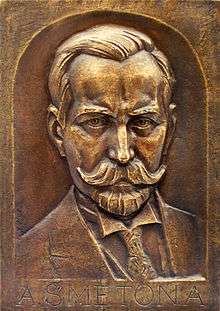

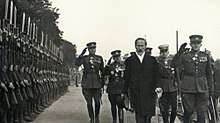
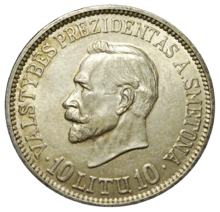
Smetona was one of the leaders of the coup d'état of 1926, which deposed President Kazys Grinius. He once again became President on 19 December of that year (two others briefly held the office during the coup, which began on 17 December, before Smetona was formally restored to the Presidency). He designated Augustinas Voldemaras as Prime Minister. One year later, he suppressed the parliament and, on 15 May 1928, with the approval of the government, he promulgated a new constitution with more extensive presidential powers. In 1929, he removed Voldemaras and assumed dictatorial powers.
For the next nine years, Smetona ruled by decree, without a parliament; his new constitution vested him with both executive and legislative powers when the Seimas was not in session. He was re-elected President in 1931 and 1938, both times as the only candidate. The Seimas was not reconvened until 1936; even then, it was composed entirely of Smetona's adherents. In 1938, a third constitution was enacted that retained the general authoritarian character of the 1928 document, and declared that political power in the state was "indivisible." He remained in office until 15 June 1940.
As a nationalist, Smetona's regime closed many Polish-language schools upon coming to power.[30] The regime repeatedly arrested and imprisoned members of the already-banned Communist Party – as with almost all interwar European dictatorships, the threat of Communism was the source of its legitimacy and the regime executed the original leadership five days after coming to power.[31] However, despite propaganda that Communists were a “non-Lithuanian force invading the country’, they continued to operate underground with growing membership and it is known today that their leaders were ethnically Lithuanian.[32]
In 1935, Smetona suffered a blow when farmers in south-east Lithuania organised a strike and refused to sell their products. Reprisals led to five deaths and 456 farmers being arrested. This exacerbated long-standing tensions within his regime between hardliners arguing for more rigid authoritarian control over Lithuanian life, and moderates who wanted liberalisation.[33] These difficulties, however, were already becoming overshadowed by the threat of Nazi Germany. Smetona’s regime was the first in Europe to put Nazis on trial: as early as 8 February 1934, action had begun against Nazis in the Memel region, which was autonomous within Lithuania.[34] The Smetona regime’s trial of Ernst Neumann and Freiherr von Sass (July 1934 to March 1935) was the first attempt anywhere to bring Nazis to justice, and saw 76 Hitlerites imprisoned and four sentenced to death[34] – though this was commuted to life imprisonment.[35] By 1938, however, Memel was becoming a difficult issue for a regime spending a quarter of its budget on defence and expensive army modernisation,[32] and the Nazis were able to win 26 of 29 seats in elections. The following year, Smetona surrendered Memel to Hitler and declared a state of emergency[36] – he never lost his distaste for Hitler and Nazism, having been so discredited by the loss of Memel that members of the Lithuanian political opposition were appointed to his cabinet[37] to try recovering credibility and domestic stability.
Smetona’s government was cautious about industrialisation, as its support base lay in the dominant rural population. As dictator, Smetona did nothing to encourage direct foreign investment, which remained extremely limited throughout his rule.[38] Nonetheless, during Smetona‘s dictatorship, Lithuania did advance economically: industrial output – mainly directed to domestic demand – when he was overthrown by the Soviet invasion was twice what it had been before the coup that brought him to power, and the country’s transport network had been greatly improved by the construction of railways from Šiauliai to Klaipėda and from Kaunas to the south and north-east. In contrast, Smetona was more generous in support for the agricultural sector, which at the time provided almost all of Lithuania’s exports despite occasionally protesting against the regime.[38]
Soviet occupation
Lithuania was occupied by Soviet troops in 1940, as a consequence of the 1939 Molotov–Ribbentrop Pact between Nazi Germany and the Soviet Union. After the USSR presented an ultimatum to Lithuania in June of that year, Smetona proposed armed resistance against the Soviets.[39] The majority of the government and the commanders of the army did not concur, believing that the country was not capable of effective resistance with Soviet troops stationed inside Lithuania.[40] On 15 June, Smetona turned his presidential duties to Prime Minister Antanas Merkys on an interim basis according to the constitution. Before leaving the Presidential Palace in Kaunas, Smetona said: "I do not want to make Lithuania a bolshevik country with my own hands." He believed that by leaving the country, he would be in a position to do more for the country's sake by leading a government in exile instead of becoming a Soviet marionette.[41] He firstly fled to Germany with his family. Shortly afterwards, the Smetonas fled to Switzerland.[42]
A day after Smetona left the country, Merkys announced he had deposed Smetona and was now president in his own right. Two days later, Merkys was pressured into appointing the more pliant Justas Paleckis as prime minister and resigning himself. Paleckis then became acting president, and was used as a puppet to oversee the final stages of Lithuania being incorporated into the Soviet Union a month later. Lithuania's current official position on the matter is that Merkys' takeover of the presidency was illegal, since Smetona never formally resigned. Lithuanian officials thus do not recognize Merkys or Paleckis as legitimate presidents, and contend that all subsequent actions leading up to the Soviet annexation were ipso facto void.
Flight abroad
— Antanas Smetona, about his motifs to leave Lithuania when his request of a military resistance against the Soviets was rejected as impossible.[43]
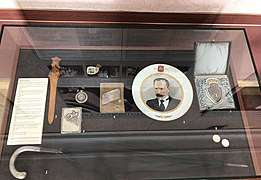
On the morning of 15 June, just after the government decided to accept the Soviet ultimatum, Smetona began making hasty preparations for fleeing the country. He was accompanied by his wife, his son and daughter and their spouses and children, Kazys Musteikis, former Minister of Defense, and two presidential adjutants. Smetona departed Kaunas at about 3 pm that day.[44] They stopped in Kybartai on the border with Nazi Germany. Smetona and Musteikis attempted to summon the 9th Infantry Regiment from Marijampolė to protect them and to offer at least symbolic resistance to the Red Army, but the regiment was stopped by a delegation sent from Kaunas to retrieve the president.[45] Smetona decided to cross the border without delay, but Lithuanian border guards would not allow him to pass. Around midnight, a local man led Smetona, his bodyguard and adjutant across the shallow Liepona stream.[46] With Smetona already on the other side, his family managed to convince border guards to let them through at about 6 am.[47]
On the German side, Smetona was met by Heinz Gräfe, a Gestapo officer. Via Königsberg, the refugees were moved to a hunting lodge near the Święcajty (Schwenzait) lake in the Masurian Lake District.[48] On 17 August, Smetona received permission to relocate to Berlin where he settled on the Rankestraße. There, he was carefully supervised and allowed to communicate only with a Lithuanian representative, Kazys Škirpa.[49] The Germans did not allow him to make any political moves so as not to upset the Soviet Union. It was clear that Smetona's presence was not desirable.[50] On 4 September, Smetona officially petitioned the Embassy of the United States in Berlin for U.S. visas.[51] The request was granted, but only on the condition that, while Smetona was in the U.S., he would not be considered the leader or representative of any state or government.[51] It was a humiliating condition, but Smetona accepted it and departed to Bern, Switzerland on 18 September.[52] Musteikis stayed in Berlin.[53]
In Bern, Smetona met with members of the Lithuanian Diplomatic Service, ambassadors and diplomats who continued to represent pre-occupation Lithuania. They hoped to establish a government-in-exile via the National Committee chaired by former Prime Minister Ernestas Galvanauskas. Smetona saw no need for such a committee and criticized the choice of Galvanauskas. The diplomats were also not receptive to Smetona – he had no funds, authority or political influence.[54] Nevertheless, Smetona signed the so-called Kybartai Act – a backdated document supposedly written in Kybartai before his exile. The Act dismissed Antanas Merkys and appointed Stasys Lozoraitis as both Prime Minister and acting President. This controversial document was never used in practice.
Smetona departed Bern for Lisbon in January 1941. He stayed in Monte Estoril, at the Pensão Zenith.[55] He left for Brazil aboard the Serpa Pinto, arriving in Rio de Janeiro on 14 February.[52] He was met by local officials and Lithuanian emigrants, and had a meeting with Getúlio Vargas, the President of Brazil.[52] Smetona departed Brazil on 26 February. On 9 or 10 March 1941, Smetona with his wife arrived in New York aboard the SS Argentina.[52] He was greeted by about 30 American journalists and photographers as well as Lithuanian-American representatives. He was escorted to The Pierre hotel where an evening function with about 400 guests was held on 13 March.[56] Since Smetona was a private individual in the United States, the gathering did not include any members of U.S. organizations.[57]
They lived temporarily at the Embassy of Lithuania in Washington, D.C., but their relationship with the representative Povilas Žadeikis was tense. Smetona then lived in Pittsburgh and Chicago before settling in Cleveland, Ohio in May 1942 with his son's family. While in exile, he began work on a history of Lithuania and on his memoirs. Smetona died in a fire at his son’s house in Cleveland on 9 January 1944,[58] and was buried there. His wife Sofija died in Cleveland on 28 December 1968. The couple were survived by their daughter, Birutė. In 1975, his remains were moved from Cleveland's Knollwood Cemetery mausoleum to All Souls Cemetery in Chardon, Ohio.[59]
See also
| Wikimedia Commons has media related to Antanas Smetona. |
- List of Lithuanian rulers
- Konstantin Päts
- Kārlis Ulmanis
References
- Merkelis 1964, p. 5
- Smetona & Smetonienė 2016, p. 94
- Smetona & Smetonienė 2016, p. 96
- Merkelis 1964, p. 10
- Merkelis 1964, p. 13
- Merkelis 1964, p. 17
- Krasniauskienė, Nijolė (5 December 2019). "Prezidentinis Smetonų duetas: laikas istorinei tiesai". regionunaujienos.lt (in Lithuanian). Retrieved 17 April 2020.
- Merkelis 1964, p. 15
- Merkelis 1964, p. 18
- Merkelis 1964, p. 19
- Merkelis 1964, p. 21
- Merkelis 1964, pp. 20–21
- Merkelis 1964, p. 27
- Merkelis 1964, pp. 22–23
- Eidintas 2015, p. 16
- Eidintas 2015, pp. 17–18
- Merkelis 1964, p. 32
- Eidintas 2015, p. 19
- Merkelis 1964, p. 35
- Žukas 2000, p. 24
- Merkelis 1964, p. 38
- Merkelis 1964, p. 39
- Eidintas 2015, p. 20
- Merkelis 1964, p. 43
- Truska 1995, pp. 18–19
- Merkelis 1964, p. 44
- Merkelis 1964, p. 46
- Merkelis 1964, p. 49
- "St. Raphael the Archangel Church". cityofmercy.lt. Retrieved 16 October 2019.
- Hiden, John and Salmon, Patrick; The Baltic Nations and Europe: Estonia, Latvia and Lithuania in the Twentieth Century; p. 56 ISBN 0582082463
- Eidintas 2015, p. 149
- Eidintas, Žalys & Senn 1999, p. 125
- Eidintas, Žalys & Senn 1999, pp. 121–123
- Eidintas 2015, p. 301
- ‘Nazis Escape Death Sentence in Lithuania: President Smetona Changes Sentence to Ward Off Trouble with Germans’; Reading Eagle, 18 May 1935, p. 1
- ‘Nazis Celebrate Return of Memel: Germans Sing and Dance While Lithuanians Weep Openly; Refugees Halted’; The Free-Lance Star (Fredericksburg, Virginia); 22 March 1939, p. 1
- Kamuntavičius, Rūstis; Vaida Kamuntavičienė; Remigijus Civinskas; Kastytis Antanaitis (2001). Lietuvos istorija 11–12 klasėms (in Lithuanian). Vilnius: Vaga. pp. 396–397. ISBN 5-415-01502-7.
- Eidintas, Žalys & Senn 1999, pp. 117–119
- Eidintas, Žalys & Senn 1999, p. 182
- van Voren, Robert; Undigested Past: The Holocaust in Lithuania, p. 24 ISBN 9042033711
- Jakubavičienė, Ingrida. "Istorijos puslapiai: kaip A. Smetona prezidentavo pasitraukęs iš Lietuvos". Kauno diena (in Lithuanian). Retrieved 17 August 2014.
- Ašmenskas, Viktoras. "Didžiosios tautos aukos". Partizanai.org. Retrieved 3 November 2017.
- Jakubavičienė, Ingrida. "Prezidentas Antanas Smetona egzilyje: "Nenoriu savo rankomis subolševikinti Lietuvą"". Pasauliolietuvis.lt (in Lithuanian). Retrieved 12 June 2019.
- Eidintas 2015, p. 387
- Eidintas 2015, pp. 388–389
- Eidintas 2015, p. 390
- Eidintas 2015, pp. 391–392
- Eidintas 2015, p. 392
- Eidintas 2015, p. 396
- Eidintas 2015, p. 399
- Skirius 2010, p. 80
- Skirius 2010, p. 79
- Eidintas 2015, p. 397
- Eidintas 2015, p. 400
- Exiles Memorial Center.
- Skirius 2010, p. 88
- Skirius 2010, p. 87
- ‘Antanas Smetona Dies in Fire: President of Lithuania Dies in Cleveland; Fled Country on Russian Occupation’; The Montreal Gazette; 10 January 1944, p. 19
- “Antanas Smetona”. Find-A-Grave. URL accessed 26 September 2006.
Bibliography
- Eidintas, Alfonsas; Žalys, Vytautas; Senn, Alfred Erich (1999). Tuskenis, Edvardas (ed.). Lithuania in European Politics: The Years of the First Republic, 1918–1940 (Paperback ed.). New York: St. Martin's Press. ISBN 0-312-22458-3.CS1 maint: ref=harv (link)
- Eidintas, Alfonsas (2015). Antanas Smetona and His Lithuania: From the National Liberation Movement to an Authoritarian Regime (1893-1940). On the Boundary of Two Worlds. Translated by Alfred Erich Senn. Brill Rodopi. ISBN 9789004302037.CS1 maint: ref=harv (link)
- Merkelis, Aleksandras (1964). Antanas Smetona: jo visuomeninė, kultūrinė ir politinė veikla (in Lithuanian). New York: Amerikos lietuvių tautinės sąjunga. OCLC 494741879.CS1 maint: ref=harv (link)
- Senn, Alfred Erich (2007). Lithuania 1940: Revolution from Above. On the Boundary of Two Worlds. Brill Rodopi. ISBN 978-90-420-2225-6.CS1 maint: ref=harv (link)
- Skirius, Juozas (2010). "Prezidento Antano Ametonos atvykimas į JAV 1941 metais ir išeivijos pozicija" (PDF). Lietuvos istorijos metraštis (in Lithuanian). 2. ISSN 0202-3342. Archived from the original (PDF) on 13 February 2017. Retrieved 12 February 2017.CS1 maint: ref=harv (link)
- Smetona, Marius; Smetonienė, Anželika (2016). "Prezidentas A. Smetona, Lėno ir Užulėnio Smetonos: genealoginė apžvalga". Lituanistica (in Lithuanian). 62 (2). doi:10.6001/lituanistica.v62i2.3342. ISSN 2424-4716.CS1 maint: ref=harv (link)
- Truska, Liudas (1995). "Antanas Smetona". In Liekis, Algimantas (ed.). Lietuvos respublikos prezidentai (in Lithuanian). Vilnius: Valstybinis leidybos centras. OCLC 654379537.CS1 maint: ref=harv (link)
- Žukas, Vladas (2000). Marijos ir Jurgio Šlapelių lietuvių knygynas Vilniuje (in Lithuanian). Vilnius: Mokslo ir enciklopedijų leidybos institutas. ISBN 9785420014578.CS1 maint: ref=harv (link)
External links
| Political offices | ||
|---|---|---|
| Preceded by None |
President of Lithuania 4 April 1919 – 19 June 1920 |
Succeeded by Aleksandras Stulginskis |
| Preceded by Aleksandras Stulginskis |
President of Lithuania 19 December 1926 – 15 June 1940 |
Succeeded by Antanas Merkys |
